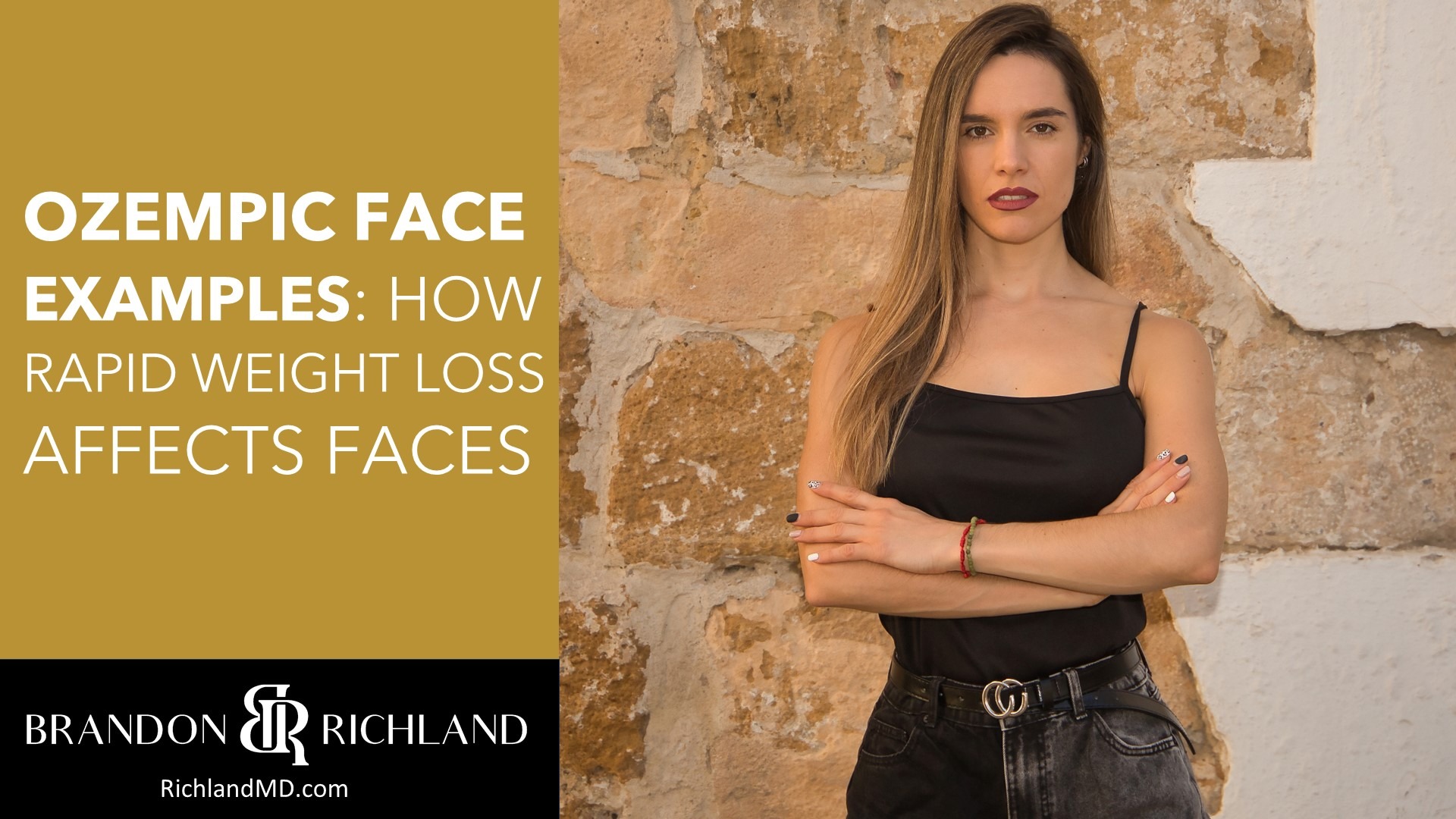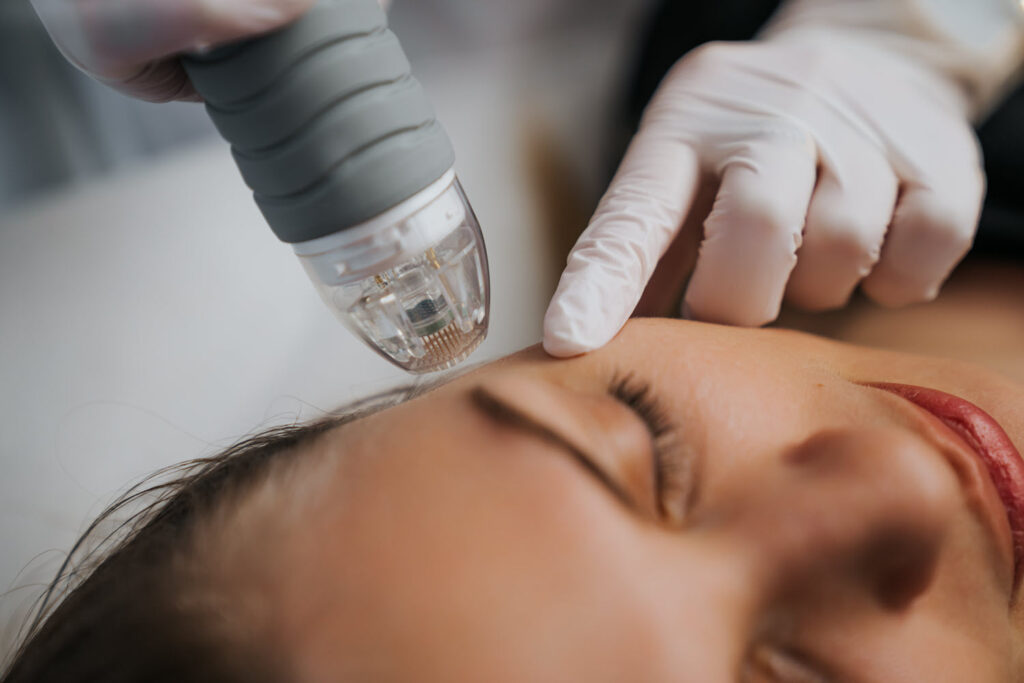Published by Dr. Brandon Richland, MD

Rapid weight loss is a goal for many, but it often comes with unexpected changes, especially in the face. As the pounds shed quickly with the use of medications like Ozempic, some individuals notice a transformation coined as “Ozempic face.” This phenomenon refers to the loss of facial fat, leading to a gaunt or hollow appearance, prompting curiosity and concern among those considering or already experiencing this change.
Ozempic, originally intended for managing type 2 diabetes, has gained popularity for its weight loss effects. With the benefit of slimming down comes a side effect that some find unwelcome: altered facial structure. The reduction of fat in the face can lead to sagging skin and an older appearance, challenging societal beauty standards and personal preference.
Key Takeaways of Ozempic Face Examples
- Rapid weight loss can change facial appearance significantly.
- Ozempic is a diabetes medication often used for losing weight.
- Facial treatments and skincare can address unwanted changes.
Understanding Ozempic and Its Use in Weight Management
Ozempic is a weight loss drug known by its generic name, semaglutide. It is primarily used to manage type 2 diabetes. This helps in regulating blood sugar levels and is approved by the FDA for this purpose.
Beyond diabetes, semaglutide is also recognized for its role in weight management. It falls under the category of GLP-1 agonists. This type of medication supports weight loss by increasing feelings of fullness, which leads to reduced calorie intake.
The Phenomenon of Ozempic Face
“Ozempic face” is a term gaining attention due to noticeable facial changes from using the medication semaglutide, also known as Ozempic. Originally for treating type 2 diabetes, it is now popular for weight loss.
This rapid weight loss can lead to a hollowed-out appearance, where people experience a loss of facial fullness. The gaunt appearance is often due to reduced facial fat, which can make features look more pronounced.
Some might notice sunken eyes as part of the changes associated with Ozempic face. The skin may not bounce back quickly enough, resulting in a more aged look. There are ways to address these changes. Options like fat transfer can help restore volume to the face, making it look fuller again. Consulting with a dermatologist or specialist can provide tailored solutions.
Keeping an eye on diet and skincare can also help support a healthier facial appearance during weight loss. Hydration and proper nutrition might aid in maintaining skin elasticity and overall facial health.

Changes in Facial Structure Post-Weight Loss
After significant weight loss, especially rapid weight loss, noticeable changes often occur in facial structure. These changes primarily include reduced facial volume and changes in skin elasticity.
Impact of Rapid Weight Loss on Facial Volume
Rapid weight loss can lead to facial volume loss. This happens when fat deposits in the face decrease quickly, leaving behind a more gaunt appearance. As facial fat loss occurs, a person might notice their cheeks appearing sunken or their eyes more hollow.
In some cases, this change is referred to as lipodystrophy, where fat disappears unevenly from different areas of the body including the face. This can make individuals look older, as youthful facial volume is linked to a smoother, more vibrant appearance. More gradual weight changes may help maintain better balance in facial features.
Significance of Collagen and Elastin in Maintaining Skin Elasticity
Collagen and elastin play crucial roles in keeping the skin elastic and firm. When people lose weight rapidly, these proteins may not adjust quickly enough, leading to saggy or loose skin.
Collagen provides strength to the skin, and elastin helps it retain its shape. When facial volume decreases, the skin may struggle to snap back, resulting in wrinkles or folds. Maintaining skin elasticity may involve good skincare, a healthy diet, or treatments that support collagen and elastin production. For some individuals, consulting with dermatologists about skin treatments can help address these concerns.
Navigating the Side Effects of Significant Weight Loss
Significant weight loss can bring desired health benefits, but it is also important to be aware of possible side effects. When using medications like Ozempic, some patients notice changes in their appearance.
Rapid weight loss often leads to a phenomenon sometimes referred to as “Ozempic face” and Ozempic butt. This can cause the face and butt to look gaunt or hollowed due to the loss of fat, impacting personal confidence.
Common Side Effects:
- Loose skin
- Increase in wrinkles
- Changes in appearance
Some individuals turn to cosmetic procedures to help manage these changes. Treatments like fillers can improve skin elasticity and restore a youthful look. Proper skincare routines may also offer relief.
Maintaining a balanced diet rich in nutrients can help support skin health. Staying hydrated is key in keeping skin supple and may reduce the appearance of wrinkles. Proper weight training is recommended for gradual weight loss.
Restorative Treatments for Post-Weight Loss Facial Changes
After significant weight loss, individuals may experience changes in facial appearance, such as volume loss and skin laxity. There are various cosmetic procedures available to address these concerns, including fillers, surgical lifts, and innovative skin-tightening techniques.
The Role of Fillers in Facial Restoration
Facial fillers are a common solution for restoring lost volume and reducing signs of aging in post-weight loss faces. Hyaluronic acid fillers, such as Juvederm and Restylane, are popular for their ability to add plumpness and hydrate the skin. Another option is Radiesse, which uses calcium hydroxylapatite to stimulate collagen production and improve skin elasticity.
For longer-lasting results, some opt for poly-L-lactic acid fillers like Sculptra. These work gradually to rebuild the skin structure by encouraging collagen growth. The choice of filler depends on individual needs, desired outcomes, and professional recommendations.
Alternatives to Fillers: Facelifts and Neck Lifts
For those seeking more permanent solutions, surgical options such as facelifts and neck lifts are effective in addressing sagging skin and deep wrinkles. A facelift targets the mid to lower face, reducing jowls and tightening loose skin. This procedure can dramatically enhance facial contours and restore a youthful appearance.
Neck lifts focus on eliminating excess skin and fat around the neck, resulting in a smoother and firmer profile. Though these surgeries involve longer recovery times compared to fillers, they offer more enduring results. Consultation with a qualified surgeon is essential to determine the best approach tailored to an individual’s facial structure and aesthetic goals.
Innovative Skin-Tightening Treatments
Recent advancements in aesthetic technology have introduced non-surgical skin-tightening treatments. Ulthera and Sofwave are innovative methods using ultrasound energy to tighten the skin by stimulating collagen production. These are preferred for their non-invasive nature and minimal downtime.
Another popular option is radiofrequency microneedling, which combines microneedling with radiofrequency energy, enhancing the skin’s texture and firmness. These treatments are appealing for those looking for gradual improvements with less recovery time than surgical methods, providing effective solutions tailored to individual skin needs.

Long-Term Strategies for Weight Loss and Facial Health
Focusing on gradual weight loss can prevent unwanted facial changes, helping maintain facial volume and skin elasticity. Coupled with a healthy lifestyle and proper skincare routine, these strategies can support long-lasting results and boost confidence.
The Benefits of Gradual Weight Loss
Gradual weight loss ensures the body, including the face, adjusts more naturally over time. This pace helps preserve facial volume, reducing the risk of a hollow or gaunt appearance often seen with rapid weight loss. It allows the skin to maintain its elasticity, minimizing the development of loose skin or exaggerated signs of aging.
Slow and steady weight loss also supports overall skin health. It allows time for building healthy habits like balanced eating and regular exercise. This approach not only supports a healthy body image but also leads to sustainable results and improved well-being.
Maintaining Results with Skin Care and a Healthy Lifestyle
Maintaining weight loss involves more than just reaching a target number on the scale. A solid skincare routine can enhance skin elasticity and combat signs of aging. Using products containing collagen-boosting ingredients or hyaluronic acid can keep the skin hydrated and firm. Regular use of sunscreen prevents damage caused by UV rays.
A healthy lifestyle is crucial, emphasizing balanced nutrition with plenty of water, fruits, and vegetables. Consistent physical activity not only aids in maintaining weight but also improves mood and energy levels. Together with a good skincare regimen, these practices help sustain facial health and overall wellness.
Frequently Asked Questions about Ozempic Face Examples
1. What Are The Common Changes In Facial Appearance After Significant Weight Loss?
Significant weight loss can lead to a reduction in facial volume, causing the skin to sag or appear more aged. Individuals may notice their cheeks become hollow or their skin loses its firmness.
2. Are There Well-Known Celebrities Who Have Shown Signs Of Facial Changes From Weight Loss Medications?
Certain celebrities have reportedly used weight loss medications, resulting in similar facial changes. This has sparked discussions in the media and among fans, highlighting the widespread nature of these transformations. Specific names and images may be found in public articles or interviews.
3. What Are Some Ways To Prevent Or Minimize The Facial Impact Of Rapid Weight Loss?
To prevent or minimize facial changes, individuals might consider maintaining hydration, incorporating a balanced diet, and using skincare products designed to enhance skin elasticity. Consulting with dermatologists for targeted treatments is also advisable.
4. How Can Someone Naturally Address Changes In Facial Appearance After Losing Weight Quickly?
Facial exercises and massages can help improve muscle tone and circulation. Maintaining a nutritious diet rich in vitamins and antioxidants supports skin health. Adequate sleep and stress management also contribute to a healthier appearance.

Conclusion and Summary of Ozempic Face Examples: How Rapid Weight Loss Affects Faces
Significant weight loss, particularly when rapid, can result in both body and facial changes. While many aim to lose fat to improve health and appearance, the process can impact facial skin by reducing volume and elasticity, sometimes leading to the so-called “Ozempic face.” Balancing fat loss across the body while maintaining a youthful and healthy complexion requires a thoughtful approach.
Strategies such as gradual weight reduction and staying hydrated can help manage blood sugar levels and protect skin integrity. Additionally, incorporating facial treatments, strength training, and a balanced diet rich in collagen-supporting nutrients can mitigate some of these changes. Consulting with healthcare and skincare professionals provides a comprehensive plan to achieve body weight goals while preserving both facial aesthetics and overall well-being.
Please note that this article is intended for informational purposes only and should not be construed as medical advice. Before making any changes to your treatments, please consult with your healthcare provider to discuss the appropriateness and safety of such changes.
Ready For Your First-Class Cosmetic Experience in Orange County (OC) California (CA)?
Are you located in one of these Orange County (OC) / Southern California cities?
Aliso Viejo, Anaheim, Brea, Buena Park, Costa Mesa, Coto de Caza, Cypress, Dana Point, Fountain Valley, Fullerton, Garden Grove, Huntington Beach, Irvine, La Habra, La Palma, Laguna Beach, Laguna Hills, Laguna Niguel, Laguna Woods, Ladera Ranch, Lake Forest, Los Alamitos, Mission Viejo, Newport Beach, Orange, Placentia, Rancho Santa Margarita, San Clemente, San Juan Capistrano, Santa Ana, Seal Beach, Stanton, Tustin, Villa Park, Westminster, or Yorba Linda?
Plastic Surgeon Dr. Brandon Richland, MD and our Cosmetic Aesthetics Team are ready to help you look and feel your absolute best.
Elevate your confidence and self esteem levels to unfathomable new heights!
Schedule your in-person consultation in our modern and luxurious offices in either Fountain Valley, CA (Main HQ) or our Newport Beach, CA office.
Do you live outside of Southern California or short on time? For your convenience, Virtual Consultations are also available.
Our warm and engaging Team of carefully selected Aesthetics Professionals will make you feel calm, cool, collected, and right at home throughout your entire consultation and surgery process.
Schedule Your Aesthetics Consultation here, or call us directly at 949-867-4496 today.
About the Author

Dr. Brandon Richland, MD is a respected Board Certified Licensed Plastic Surgeon in Orange County / Southern California specializing in cosmetic and reconstructive surgeries.
Driven by his passion for medicine, Dr. Richland obtained his Doctor of Medicine (M.D.) degree from the prestigious program at Saint Louis University (SLU) School of Medicine in 2013. His exceptional skills were recognized when he received the McGraw Hill / Lange Medical Student Academic Achievement Award, and graduated top of his class with Honors. For his undergraduate degree, he attended University of California, Los Angeles (UCLA) and graduated with Honors in 2009.
To further enhance his surgical expertise, Dr. Richland completed his Residency in Plastic Surgery at the University of California, Irvine (UCI) from 2013 to 2019 earning the Academic Achievement Award twice during this period. A total of 14 years in dedicated schooling and medical residency.
Dr. Richland is actively involved with healthcare and medical societies, as a Diplomate of the American Board of Plastic Surgery, a member of the American Society of Plastic Surgeons, American Society of Aesthetic Plastic Surgeons, and the California Society of Plastic Surgeons.
Contact Dr. Richland today by visiting RichlandMD.com, scheduling a cosmetic consultation, or by calling 949-867-4496 directly.
Cover Image Credit: Dmitryag / 123RF.com (Licensed). Photo Illustration by: Dr. Brandon Richland, MD.










